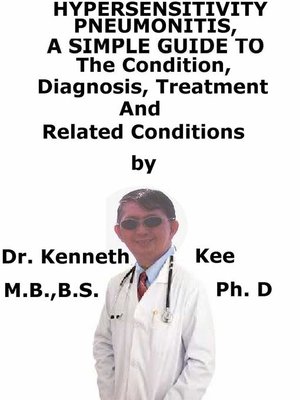Hypersensitivity Pneumonitis, a Simple Guide to the Condition, Diagnosis, Treatment and Related Conditions
ebook
By Kenneth Kee

Sign up to save your library
With an OverDrive account, you can save your favorite libraries for at-a-glance information about availability. Find out more about OverDrive accounts.
Find this title in Libby, the library reading app by OverDrive.



Search for a digital library with this title
Title found at these libraries:
| Library Name | Distance |
|---|---|
| Loading... |
This book describes Hypersensitivity Pneumonitis, Diagnosis and Treatment and Related Diseases
Hypersensitivity pneumonitis (HP), previously termed extrinsic allergic alveolitis, happens when the lungs form an immune response (hypersensitivity) to something the patient breathes in which causes inflammation of the lung tissue (pneumonitis).
Hypersensitivity Pneumonitis is an inflammatory disorder of the lung caused by the inhalation of irritating microscopic particles or antigens.
These antigens may be from many different sources.
The most frequent sources are any of a number of different types of mold or proteins from animals (particularly birds).
Once inhaled, these antigens cause inflammation and can finally cause major damage to the lung.
It is important to confirm a diagnosis of hypersensitivity pneumonitis early since it has a very good prognosis if caught and treated before its later stages.
In its later stages, the lung damage from hypersensitivity pneumonitis can be irreversible and may result in a significantly reduced quality of life.
It is not contagious, even though it is possible that other people around the patient may be exposed to the same antigens
Some hypersensitivity pneumonitis is:
Bird fancier's lung:
This is the most frequent type of hypersensitivity pneumonitis.
It is caused by repeated or intense exposure to proteins present in the feathers or droppings of many species of birds.
Farmer's lung:
This type of hypersensitivity pneumonitis is induced by exposure to dust from moldy hay, straw, and grain.
There are 3 types, based on how long the patient has had the disease and how severe the symptoms are.
1. Acute.
This type is brief and severe.
It feels like the patient caught the flu, and it happens after the patient has been around a lot of dust.
The symptoms should get better in a couple of days if the patient does not breathe in any more dust but will probably return if the patient does.
The symptoms could include:
1. Cough
2. Shortness of breath
3. Tight feeling in the chest
4. Fever
5. Chills
6. Sweating
7. Tiredness
The patient might have these symptoms from 12 hours to several days.
2. Sub-acute.
It can happen when the patient have low-level contact with the dust over time.
It may begin with a fever.
Then shortness of breath, tiredness, and coughing can begin over weeks or months.
This type of hypersensitivity pneumonitis is likely to get worse with time.
3. Chronic.
This is a long-lasting type that happens after a low but long duration of contact with dust.
The patient may get symptoms like shortness of breath, tiredness, coughing, and weight loss that slowly get worse.
This type of hypersensitivity pneumonitis can cause permanent lung scarring.
Hypersensitivity pneumonitis normally happens in people who work in places where there are high levels of organic dusts, fungus, or molds.
Long-term exposure can cause lung inflammation and acute lung disease.
Diagnosis
The doctor will check the oxygen levels in the blood.
Aspergillosis precipitin blood test to check for the aspergillus fungus
Full blood count
Hypersensitivity pneumonitis antibody blood test
Krebs von den Lungen-6 assay (KL-6) blood test
A lung function test may help the doctor decide how severely the lungs are involved.
Bronchoscopy with washings, biopsy, and bronchoalveolar lavage
Surgical lung biopsy
Treatment:
In most cases, hypersensitivity pneumonitis can be treated by simply avoiding inhalation of the responsible antigen,...







